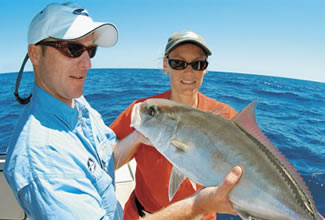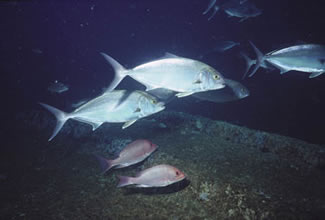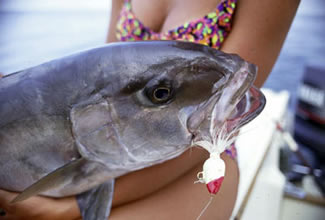May 16, 2011
By Jeff Weakley
Looking at Florida reefs through amber-colored glasses.
By Jeff Weakley
 Assistant Editor Terry Gibson and Sharon Niemczyk inspect an undersize amberjack hooked on a wreck off Martin County. |
What's with all the small amberjacks these days?
What happened to those big brawlers—the 60-pounders that humbled the proud, entertained guests, made slow days exciting?
Advertisement
I get the feeling you've had a few days like this:
A wreck in 180 feet of water, prime AJ season. We had a crew of five, including a young lady game enough to tackle anything.
Advertisement
I offered Sharon Niemczyk a fighting belt, and wished her luck.
We'd passed over the wreck once already, confirming the bearing and range we'd need to set up downcurrent. Next drift would be the one, I told her.
When I said go, she flipped the lever on her standup outfit and let 50-pound braid spool off into the deep blue. A 16-ounce bank sinker on the bottom of a three-way swivel dragged a quarter-pound live grunt to its destiny.
When she hit bottom, Sharon cranked up several turns. She had a look of cautious optimism. An experienced offshore fisher, she knew what a big AJ was capable of, but we'd sold her on the idea of “research.” Sharon's background is marine biology, and I guess that's why she agreed to our informal, Tuesday morning project.
The moment the edge of the wreck appeared on the fishfinder, Sharon's rod doubled. She choked up her grip, arms shaking, rodtip pulsing wildly.
The fight was AJ all the way—the big jacks don't self-inflate like grouper—but something didn't seem right. It just wasn't the same.
 Greater amberjacks underwater. |
Soon, too soon, up popped Sharon's amberjack—all of 25 inches. She had scarcely broken a sweat.
In 1985, the late Don Mann, who chronicled the South Florida offshore scene for FS, wrote: “In any month of the year, private and charter craft alike can find action, when the surface trolling gets slow, because the depths of the [Islamorada] Hump are home to resident schools of giant amberjack. These husky battlers are not seasonal. There is no time of year when they are “running.” This hotspot has yielded countless amberjack over 75 pounds, and some over 100.”
The Hump, of course, was (and still is, sort of) AJ central. But many deepwater wrecks and reefs around Florida held similar schools of monster jacks.
A few years later, in 1989, Mann brought us the hint of something amiss:
“Neither Florida nor the federal government imposes any restrictions at all on the taking of amberjack, although regulations are presently being mapped for federal waters.”
What was happening in this time frame was a rapid, unregulated escalation of commercial amberjack fishing: from less than 100,000 pounds per year on Gulf and Atlantic coasts, to a million pounds or more by the early 1990s. The explosion filled in partly where redfish supplies were left out of the notorious “blackened redfish” craze. Reds were mostly taken off the market in 1989, but white AJ fillets were evidently a fine substitute. Recreational effort increased somewhat through the '80s, apparently following the crash in Gulf kingfish stocks (which, like redfish, had nearly been netted into the history books).
Greater amberjack have never been what we'd call discerning feeders. Where they're thick, the only real “skill” required of the angler lies in evading them—which is what many grouper and snapper fishers would prefer to do. For decades, landing a big AJ, one 50 pounds or up, was seen as a brutal rite of passage on offshore boats. That or a form of torture for unwitting tourists. Finding AJs was seldom a problem, particularly in spring, March through May, when spawning-grade fish would clot a depthfinder on certain wrecks and reefs.
Over the Islamorada Hump and other AJ gathering areas, commercial “jack boats” outmuscled their quarry with vertical “bandit” rigs powered by electric motors. On shallower reefs, divers began deploying spearguns equipped with explosive charges.
For a while, people took AJs for granted, turning a blind eye toward the sudden rise of market pressure. But a curious thing happened: As stocks bottomed out, sportsmen began waxing nostalgic for the big ocean brawlers.
“I remember one family who fished with me in the mid '80s,” recalled Capt. Bouncer Smith, a Miami charterboat captain. “We'd start every trip with three outfits, 30- to 50-pound test. I'd give 'em each a 4- or 5-ounce bucktail; they'd all line up on the railing, each drop a bucktail, jig and wind, and all the rods bent over. When they'd caught 25 AJs, they'd finally lay down on the deck and beg not to catch another one. By that time they wouldn't mind waiting for a sailfish bite.”
 Where they're abundant, a bucktail jig is all the "bait" you need. |
Last week I phoned a number of veteran anglers from different parts of Florida, including Bouncer. How does today's AJ fishery compare?
“The good news is,” said Smith, with a note of irony, “two weeks ago I was fishing some youngsters from Connecticut, and we spent one afternoon catching 5- to 10-pounders one after the other. The bad news is, here we are in the height of AJ season, and guys are talking about catching two or three. Or one. I guess the bright side is, because there are no AJs, it's easier to catch grouper nowadays.”
Six or seven years ago, off Jacksonville, I allowed myself to be victimized by timeless hazing. I knew good and well what was under the boat, but I grudgingly took the rod given to me by new (at the time) FS Live radio show director Rick Ryals. We were on an isolated shrimpboat wreck, one in the logs of local skipper Dennis Young, on whose boat we were fishing.
“Here
Jeff, take this one; you're sure to hook a big grouper,” Ryals said, chuckling.
My cigar minnow didn't make it ten feet below the boat before a 40-pound AJ hammered it. When the crew saw that I wasn't going to be “whupped,” they too dropped baits and for a few minutes four of us arm-wrestled AJs.
“In the last 10 years, we've seen a dramatic decline and drop in size,” Ryals said recently. “The best judge I have is the captain of our partyboat King Neptune, Scott Reynolds. He's kept track of catches, and says the average size jack here is now 14 pounds. I don't think there's any question we're in trouble.”
On reefs within 30 miles of Mayport, it's common to see commercial dive boats anchored up. Scuba-equipped crew members use explosive “powerheads” to nail AJs.
Amberjack are managed as two separate stocks, by two different federal agencies: one for the Gulf of Mexico, one for South Atlantic waters. Both have what are optimistically termed “rebuilding plans.”
| AJs and Kin | Greater amberjack (Seriola dumerili) is the largest of the amberjacks in Florida. Distribution is widespread—pretty much any structure in salt water deeper than 40 feet is likely to hold AJs at some point. Recreational bag limit is 1 per person. Minimum size is 28 inches, measured from tip of the nose to fork of the tail. Commercial fishers with appropriate permits must abide by a 36-inch minimum size, a 1,000-pound trip limit, and seasonal closures: April on Atlantic waters; March through May on Gulf waters. The commercial season is closed for the year if the annual quota is reached.
A similar species is the almaco jack (S. rivoliana), differing with a more compressed body and a longer, sickle-shaped dorsal and anal fin. Both have the characteristic dark eye band. No specific regulations for almacos.
Lesser amberjack (S. fasciata) are a lot “less”—seldom larger than a foot or so. Otherwise, they look like greater AJs. Recreational bag limit is 5 in an aggregate that includes banded rudderfish (S. zonata), another small ocean jack. Size limit for both species is at least 14 inches, and no larger than 22 inches.
The yellow jack (Caranx bartholomaei) is a fish somewhat similar in profile to the amberjacks. It shares habitat and habits, at least in southern peninsular Florida, hanging around wrecks and structure, such as navigational markers. This may be one of the finest eating fish around. It tops out around 20 pounds. Some call this a bar jack—though that is technically a different species. No regulations.
All the AJs are good release candidates; only in the deepest water and most rapid ascents will they “blow up” like groupers and snappers do. Usually you can unhook a jack and toss it back. If not, you can vent them. Big AJs—over 20 pounds or so—often have worms in the tail section, but the “shoulder” meat is usually fine.
—J.W.
|
|
This spring, the National Marine Fisheries Service announced that amberjack fishers in the Gulf (recs and commercials) had exceeded their 2003 total allowable catch by 53 percent—more than 1.5 million pounds over.
Under the Gulf rebuilding plan, total landings for 2003 should not have exceeded 2.9 million pounds. The Gulf of Mexico Fishery Management Council attempts to hold fishers to figures like this through bag and size limits, as well as a “quota” for commercial anglers (meaning when commercials reach a certain figure, they aren't allowed to catch any more).
As it turns out, the NMFS had calculated 4.45 million pounds of landings in 2003—by mistakenly using an obsolete method of gauging charterboat catches.
Captain Bob Zales, who runs charters out of Panama City Beach, has been active in Gulf amberjack conservation since 1989. A few years ago, he helped NMFS develop a For Hire Survey (FHS), to better capture charterboat landings. Random phone surveys—the old Marine Recreational Fisheries Statistical Survey (MRFSS)—weren't likely to get a complete picture, as charter customers largely come from outside the state.
“FHS identifies the universe of charterboats; they randomly sample us, 10 percent of the fleet per week in the Gulf,” Zales explained. “When NMFS corrected its figures for 2003, they indicated the overall landings were pretty close to 2.9 [million].”
In a nutshell, federal fisheries managers have finally taken strides to help AJs recover, but they seem to have little grasp of what is actually occuring. Small errors in statistics are always expected—and usually built right into rebuilding plans—but it seems wildly improbable that the feds could arrive at such vastly differing figures. Then again, the same agency once concluded that recreational anglers caught 124,000 king mackerel from shore in one year.
Perhaps the most unsettling question is, why did NMFS bounce back to a figure showing extremely high recreational landings?
On the Atlantic side, NMFS has a clear history of commercial favoritism, where AJ stocks are concerned.
In 1997, the South Atlantic Fishery Management Council, under heavy pressure from sportsmen and conservationists, was poised to close commercial take during March, April and May. The three months represent peak spawning season, when AJs are stacked up and vulnerable around certain wrecks and reefs. The Council had already explored the idea of seasons, finding that a single month closure was ineffective.
 Distant reefs still produce impressive battles, like the one Katey Sykes fought while pulling in a 93-pounder 75 miles southwest of St. Petersburg. |
“However,” recalls Ted Forsgren, Executive Director of Coastal Conservation Association Florida, “just weeks before the final vote, NMFS approved new members to the Council that changed its composition in favor of commercial interests...NMFS removed Florida's conservation and recreational fishing representation seat and replaced it with a paid lobbyist for the commercial fishing industry.”
Worse, the lobbyist actually worked for South Florida commercial fishermen accustomed to loading up on AJs during the spawning season.
Predictably, “The newly appointed council member/lobbyist and the NMFS regional administrator cast the deciding votes to reject the three-month spawning season closure and substitute less effective commercial controls.
“The federal regulations simply reduced recreational take and enhanced the commercial takeover of the fishery.”
In fairness to the councils and NMFS (or should I say, in spite of), there are hints of recovery in AJ stocks.
“It's slowly improving in my area,” said Capt. Ralph Allen, who owns Kingfisher Charters in Punta Gorda, on Florida's lower Gulf Coast. “Twenty years ago, if you didn't have a 70-pound amberjack, you didn't have anything special. I haven't seen one of those in a long time. With the AJ regs, we're starting to see more small fish, and some 15- to 20-pound keeper fish.”
Out in very deep water, there are still pockets of large amberjack. Field Editor Buck Hall, who fishes out of Pensacola, noted that big catches are still relatively common—in 300 feet of water, some 70 miles from shore.
The Islamorada Hump has yet to recover, but a more distant seamount in the Straits of Florida—too far for commercial boats—has held some jumbos, according to Capt. George McElveen of the Islamorada charterboat Reel McCoy.
But then there's the issue of localized overfishing, particularly near population centers with major charterboat industries. “Local boats keep the wrecks cleaned off here,” said Bouncer Smith of Miami. “Four to five boats on each wreck, six tourists on each boat, keeping a limit—if they can find that many in the course of a day.”
We know that some AJs are migratory—particularly those in Atlantic waters—but analysis of tagging recaptures shows that there are also resident fish.
Bob Zales did some tagging in the early '90s, and found AJs that stayed in the same basic area.
“I felt if we got the size and bag limits correct, we could have a sustainable fishery and not worry about it,” he said. “Prior to the '90s, I could wear you out all day long on 50-pound-plus fish. Now we catch a 50-pounder once a year. There's still an abundance of smaller fish, lots of fish a half-inch short of legal size, which is 28 inches.”
Scientists tell us that AJs grow quickly, with females reaching 34 inches in two or three years.
Are those little AJs a good sign or a bad sign? Time will tell.
FS
